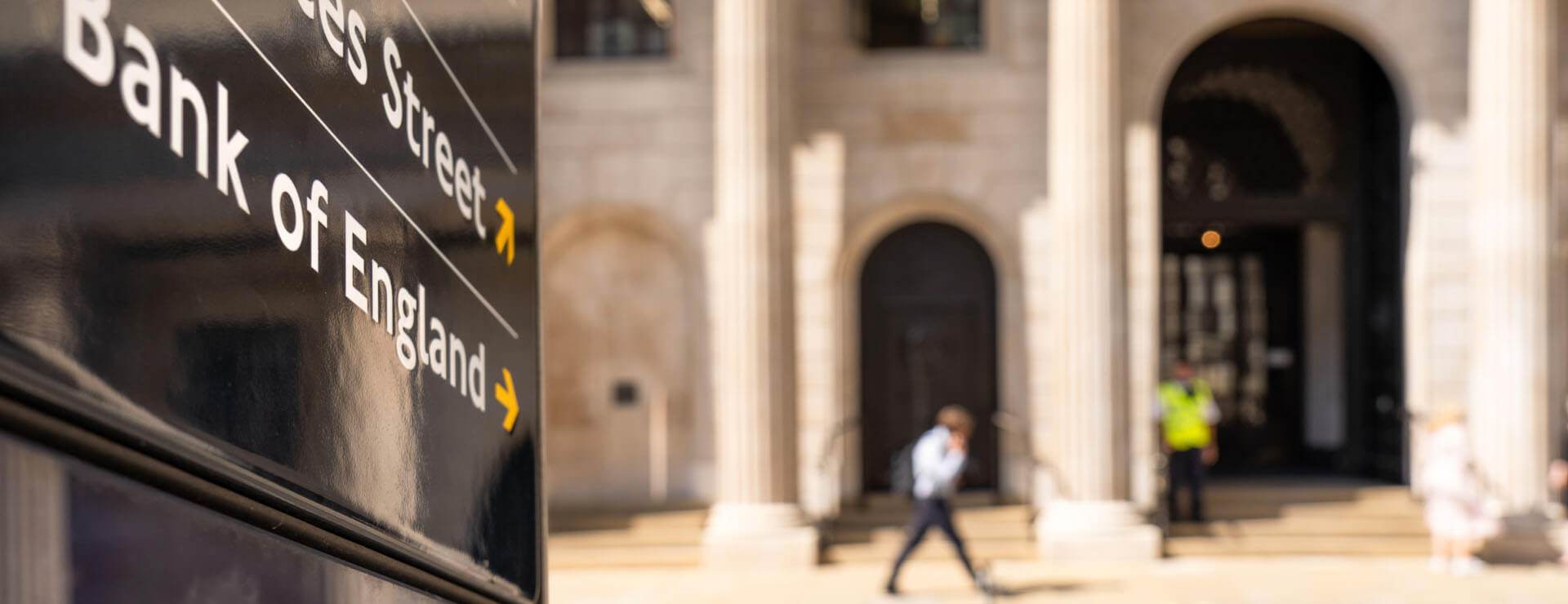
Just as we were looking forward to enjoying a more normal festive period, the arrival of the Omicron variant heralded a Christmas morning of stockings filled with masks, boosters and lockdowns. Following significant gains in 2021 the going is likely to prove harder in 2022 as the stimulus tailwind fades, monetary conditions tighten and debate rages as to the pace and scale of interest rate rises.
Markets in 2021
- Equities powered ahead in 2021, with the MSCI All Countries World Total Return index returning 20.7%, in local currency terms.
- The US was the best performing market, partly due to the presence of a small number of the world’s biggest companies, which significantly outperformed.
- Overall, developed markets outperformed emerging markets. In a reversal of 2020, Chinese equities were among the poorest performers.
- Bond markets remained calm, even as inflation proved more persistent than first anticipated and central banks stepped up plans for economic tightening.
Outlook for 2022
- Global growth remains strong by historic levels, if slowing relative to 2021. This should continue to support equity markets.
- After a strong 2021, equity markets are likely to prove more volatile in 2022 as investors consider the impact of accelerated central bank tightening schedules.
- The arrival of new COVID variants – and subsequent lockdowns – remains a risk. However, governments are now well-versed in containment and the trend seems to be towards less lethal, albeit more infectious, variations which should require a lighter touch.
- Inflation will be with us for some months yet but is expected to ease towards the end of the year. Longer-term, it should return to within central bank target range of around 2%.
- Central banks are likely to continue to raise interest rates gradually and tighten the money supply by reducing bond repurchase programmes. This could have an impact on equity markets, although liquidity remains high by historical standards.
- The slowing Chinese economy – the second largest in the world after the US – could act as a drag on global growth.
2021 Market Returns
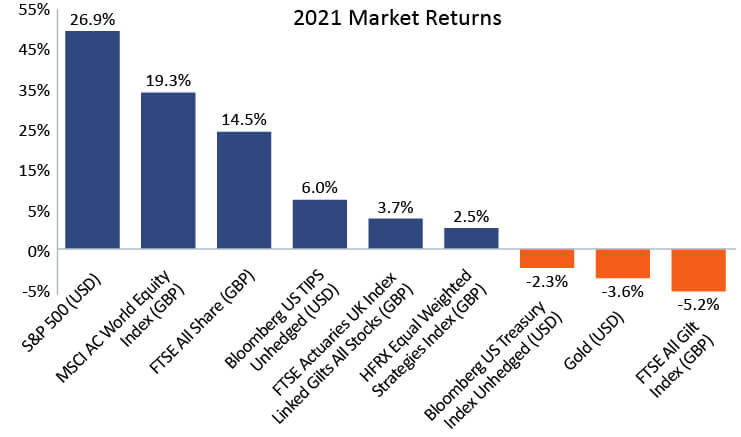
Returns shown on total return basis. Past performance should not be relied upon as an idicator of future returns. The value of an investment and the income from it can go down as well as up and investors may not get back the amount invested. This chart provides a limited snapshot of market performance. For a longer-term view please see the tables at the end of this document. Source: Bloomberg/James Hambro & Partners. January 2022.
2021: Liquidity kept the punchbowl full and the party swinging
2021 proved to be a good year for risk takers and asset markets as animal spirits verged on the carnal. The US was strongest performer, with both the economy and the S&P 500 responding to the economic cocktail doled out by the Federal Government and Federal Reserve, but capital markets globally were in record-breaking form. Companies continued to take advantage of the ultra-loose monetary conditions to raise a record $12.1 trillion by selling shares and issuing debt, 17% higher than the record year of 2020 and 25% up on pre-pandemic 2019. Much of the money found its way into M&A with total transactions of $5.8 trillion, 54% up on 2019.
Record cash raised through equity, debt and loans in 2021
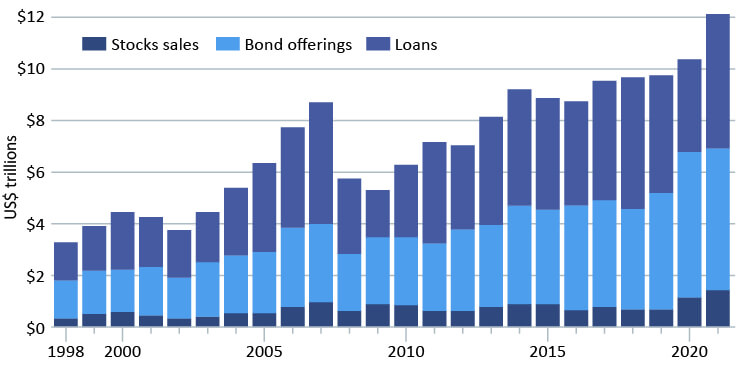
As at 27 December 2021. Source: Datastream Refinitiv.
Equity markets surge ahead
After pausing for breath over the summer, with sentiment spooked by the spread of the Delta variant, equities were resurgent in the final quarter. The MSCI All Companies World Index rose 6.5% (in local currency terms and including income) over the lase three months of the year, for a full year return of 20.7%.
The US led, with the S&P 500 rising 28.7% over 2021, reflecting both the strength of its economy and being home to some of the strongest technology platforms that thrived during the pandemic. At the other end of the scale, China fell -3.5% as a slowing economy, a crackdown on their own technology companies and fissures in their heavily indebted property sector weighed.
These two represented the extremes of a divergence between developed and emerging markets. Developed countries were buoyed by supportive policy, vaccine rollouts and recovering economies. Emerging markets, by contrast, have been prone to harsher restrictions and more frequent lockdowns, in part due to less successful vaccination programmes, while government support has been less generous. Inflation has also prompted tighter monetary policy in many emerging markets.
At a sector level, all global sectors closed in the black, led by energy, which rebounded from a torrid 2020 to return 38%. Oil prices staged a strong recovery, up 50% over the year from the extreme lows of 2020.
Financials also performed well, returning 25% as rising interest rates and low levels of debt defaults buoyed the banks, while brokerages and corporate financiers feasted on the strength of capital markets. Technology had another good year, returning 28%, although under the surface there was a huge divergence between winners and profitless losers.
The headline strength masked an evolving underlying dynamic: market returns being increasingly driven by an ever-smaller number of large stocks. The 10 biggest companies today represent a larger proportion of the market than at any time in the last forty years.
The 10 biggest companies dominate the market
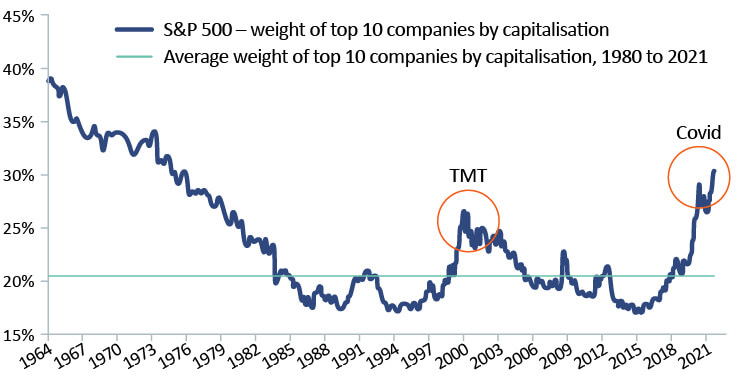
Source: JP Morgan Equity Macro Research. December 2021.
More than half the return from the US market since the spring has been down to the growth in just five companies: Microsoft, Alphabet (Google), Nvidia, Tesla, and Apple (the first $3 trillion company, less than four years after becoming the first $1 trillion business).
Beyond the big five, returns have been much more uncertain. Many companies have fallen 40% or more from their twelve-month peak, particularly those high growth/no profit businesses that surged ahead in 2020.
Performance of the S&P 500 in 2021 dominated by the 10 biggest companies
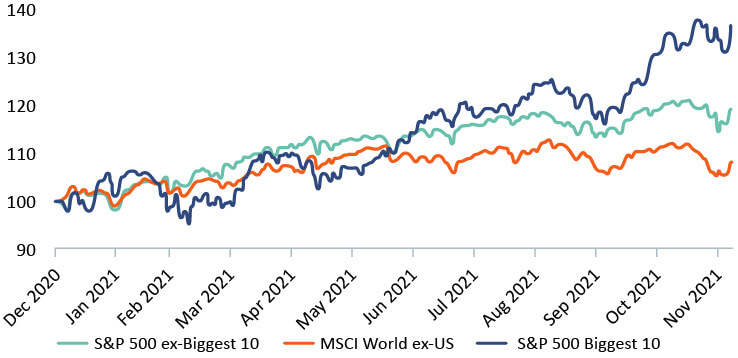
Price performance of S&P 500 in 2021, rebased to 100 as at 31 December 2020, US dollars not including income. Past performance is not an indicator of future returns. The value of your investment can go down as well as up and you may not get back the amount you first invested. This chart shows a limited snapshot of market performance. For a longer-term view, please refer to the data at the end of this article. Data as at 22 December 2021. Source: FT Unhedged.
Bonds thrive despite inflation, while gold struggles
In a quarter when inflation moved ever higher and monetary policy pivoted, bonds proved surprisingly resilient, with UK gilts and US Treasuries up 2.4% and 0.2% respectively. Our preference for inflation-protected securities as a hedge against persistent price pressures was rewarded as UK index-linked bonds delivered a calendar year return of 3.7% and out-performed conventional gilts, which fell -5.2%, by 9%. The picture was similar in the US bond market, while US inflation-linked bonds were even stronger.
Gold disappointed, falling modestly. With inflation on the march there was an understandable expectation that prices would move higher, but the subsidence of broader risks meant there was less demand for gold’s protective qualities. It also reflected some competition from potential digital alternatives in the cryptocurrency realm, specifically Bitcoin, although not many stores of value fall 40% in six months.
Growth + Inflation = Monetary policy lift off
At a basic level, the policy response to the pandemic has served to increase demand and reduce supply, fuelling the return of inflation for the first time in a generation.
Inflation has spiked in 2021
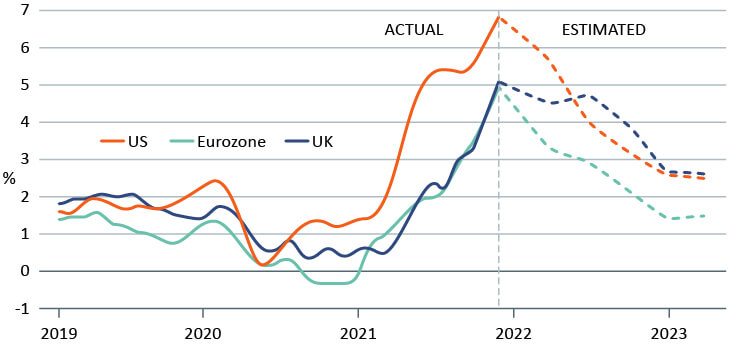
Monthly annual inflation rates. Source: Bank of England, European Central Bank, US Federal Reserve, Bloomberg economist surveys. December 2021.
Headline inflation continued to rise through Q4, surprising central bankers who had expected the rise in prices seen in the second quarter of the year to prove temporary and to begin abating in the latter part of the year.
With GDP surpassing pre-pandemic levels, unemployment falling, growth above trend and inflation rising, all the ingredients were in place for a turn in monetary policy at the end of 2021 – and that is what we got. This marks a new phase of the cycle as we transition from the recovery phase to a more self-sustaining mid-cycle period when the stabilisers can be removed.
The US Federal Reserve had been at pains to signal its plans to reduce its $120 billion monthly liquidity injections through the summer, desperately trying to avoid a repeat of Ben Bernanke’s 2013 ‘taper tantrum’. It duly delivered on those expectations before announcing that it would accelerate the pace of withdrawal and will have ceased buying bonds in March, all with little more than a shrug from markets. Coming on the heels of November’s 6.8% inflation number, Fed chair Jay Powell also indicated that they expect to raise interest rates three times in 2022, which will still leave rates below 1%. The futures market agrees with the Fed, expecting a further three or more rate rises in 2023.
The futures market is in line with the Fed’s dots
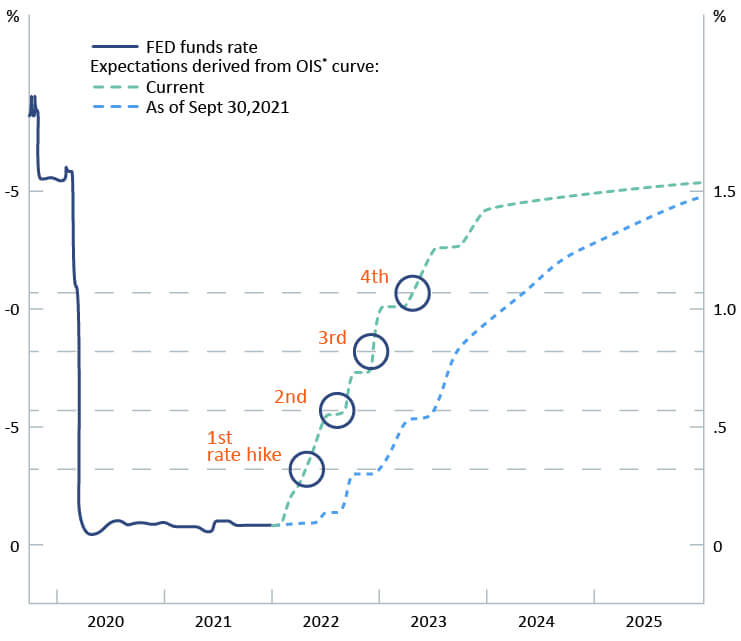
Source: Bank of America. January 2022.
The UK is also in modest tightening mode. The new Governor of the Bank of England, Andrew Bailey, broke with convention and raised UK rates to 0.25% in December as UK CPI inflation reached 4.8%, the first time they have ever raised rates on the eve of Christmas. The situation in Europe remains more balanced, but even the ECB has begun to plan a slowdown in its support. German Bund yields are inching back towards zero.
“Prediction is difficult, especially about the future” – Nostradamus
The runaway growth and performance in 2021 is going to be hard to repeat. However, while the first weeks of 2022 have provided ample demonstration of the market volatility we could expect for markets, there are reasons to expect further progress, not least the ongoing health of the economy.
Growth does not look like a problem
The recovery from the shortest recession on record is very much in place. According to data from the OECD, output for the 38 members is above pre-pandemic levels while unemployment rates are already in-line with longer-term norms and falling.
Over the year, the US is likely to have grown by 6%, slightly faster than the G7 at 5%, but all major economies are growing faster than average.
The US unemployment rate has fallen back from over 13% to 3.9%. With unfilled job openings of over 10 million exceeding the seven million registered as unemployed, the prospects for continued falling unemployment look rosy.
US unemployment rate has plummeted to below pre-pandemic levels
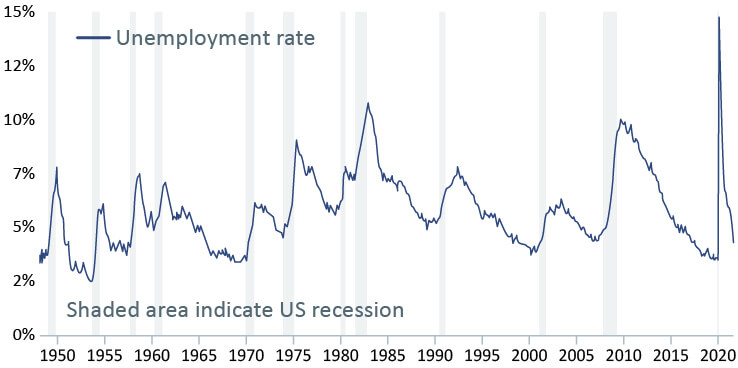
Source: US Bureau of Labor Statistics. December 2021
Consumers may be feeling unwell, but their bank accounts look very healthy
Consumers remain in rude financial health. The generous support offered by governments and rock bottom interest rates have led to falling levels of indebtedness and lower costs of servicing that debt. The surge in stock markets and housing has added more than 20% to household wealth and savings are up $2 trillion over the pandemic. As unemployment rates have fallen, wages have begun to rise.
This has translated into a complete rebound in personal consumption relative to the pre-pandemic trend, albeit an uneven one. Demand for goods is far higher than pre-2020 levels, while spending on services and experiences continues to suffer from ongoing COVID interruptions. As restrictions lift and behaviour settles, restaurants, theatres and hotels should begin to fill up. Given the importance of the service and hospitality sectors to western economies this should add another leg to the recovery.
Lockdowns have encouraged spending on goods over services
US real spending on goods and services relative to pre-pandemic trend
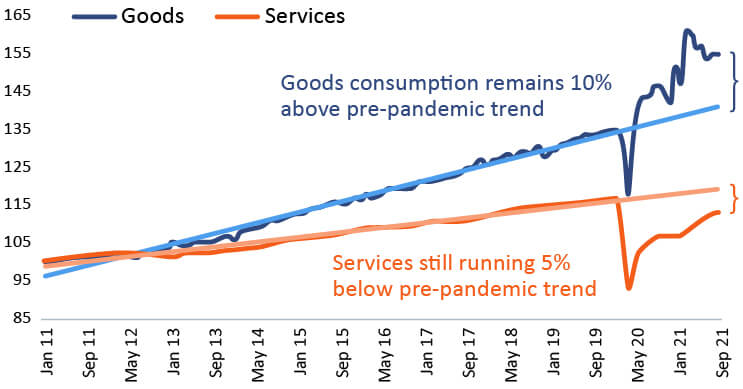
Scale set to 100 as at Jan 2011. Data as at November 15, 2021. Source: Bureau of Economic Analysis, Census Bureau, KKR Global Macro & Asset Allocation analysis.
Companies look ready to join the spending party
The strength of the consumer is mirrored in the corporate sector. Companies, like consumers, have swollen their coffers and built out their own balance sheets given abundant liquidity and the low cost of debt.
The recent corporate earnings season saw companies ready to invest, with rising capital investment commitments across a multitude of sectors, unsurprising given the collapse in investment through the crisis. Business investment will rebound in 2022 as firms seek to rebuild inventories run down through the crisis and impacted by supply disruptions, creating capacity to meet rising demand.
Business investment should increase in 2022 from current low level
Business fixed investment in equipment and structures as a percentage of US GDP
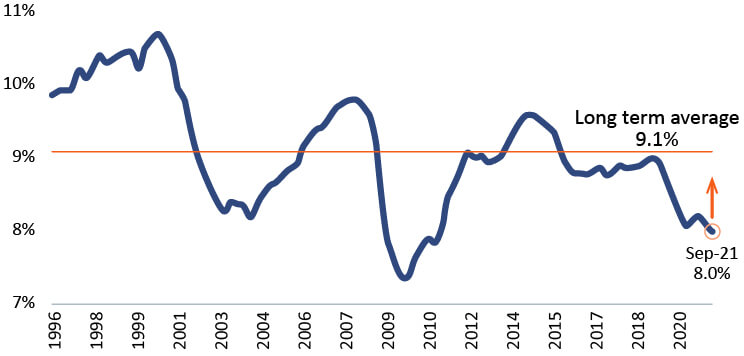
Source: US Bureau of Economic Analysis, US Census Bureau, KKR Global Macro & Asset Allocation analysis. November 2021.
Fiscal torrent slows but government spending still flowing
The fiscal ordinance that was brought to bear to defend economies through 2020 and 2021 will naturally be stood down in 2022, but the prior decade’s mantra of fiscal austerity looks like a more permanent casualty of the pandemic. The major objectives of governments across the world are similar: reduce inequality and transition to a low-carbon economy. Neither can be effectively achieved without governments continuing to spend.
Spending should change focus as priorities shift from disaster relief to social support and renewing infrastructure. This won’t create the same sugar-rush as handing out cash, but it will have a more enduring impact on potential growth.
If bonds are the answer, can someone please explain the question?
Absolute yields on bonds remain low and real yields, after adjusting for inflation, are steadfastly negative. The stock of negative-yielding bonds remains in the trillions of dollars. With interest rates set to rise and inflation proving more persistent, we see little opportunity for bonds to deliver either much return or diversification benefit in the next six months.
The negative-yielding bond mountain mountain remains high
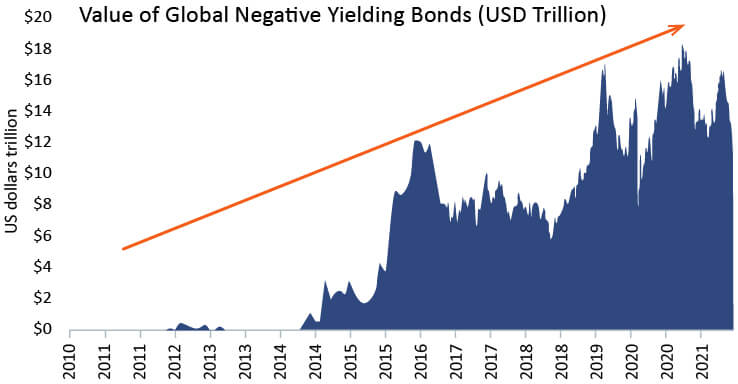
Bloomberg Barclays Aggregate Negative Yielding Bond index. Source: Bloomberg. October 2021
At James Hambro & Partners, we spent much of the year more worried about inflation and rising rates than many of our peers. Where we do own bonds, our focus is on the safest government bonds, which at the very least should prove a haven in the event of a market shock. Within these, our preference has been for inflation-linked bonds to protect against the additional tail risk of inflation.
Buckle up: equities still supported by the cycle and earnings but likely to prove a wilder ride
Following stellar returns in 2021, on top of positive returns in each of the last three years, it is understandable that some are wondering where next for equities. Having seen valuation multiples expand and margins swell through the pandemic, much of the good news associated with the recovery is reflected in prices and we cannot expect to rely on a repeat of in the face of rising costs and interest rates. The first weeks of 2022 have already brought some volatility to markets.
“Don’t bet against stocks unless you think that there is a recession around the corner” – Peter Berezin BCA research
Recessions and bear markets tend to overlap
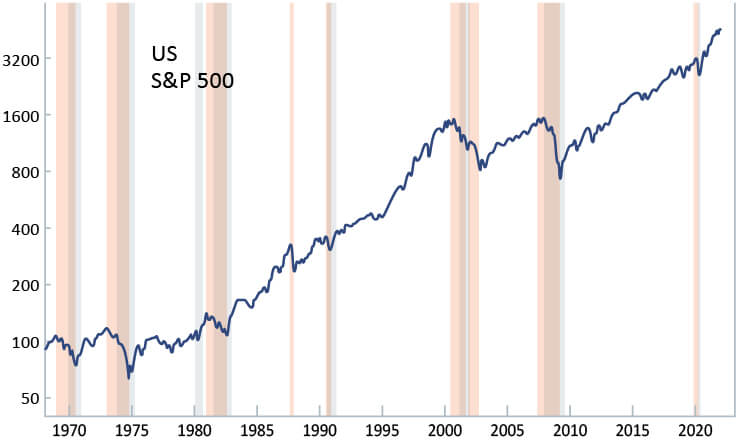
Note: S&P 500 cumulative return shown in log scale. Red shading indicates bear market; grey shading indicates NBER defined recessions. Source: Bank of America. December 2021.
With a positive economic backdrop and interest rates that are likely to remain extremely low by all historic standards, earnings should continue to grow, supporting equity prices. Current consensus forecasts are for global earnings growth of 8% this year, which does not look ambitious. Should the pandemic subside, and supply begin to normalise, then we could see upgrades to these growth expectations over the course of the year. With little to indicate an economic contraction on the horizon, equity market returns should be similar to the growth in earnings.
Company earnings should continue to grow this year and next
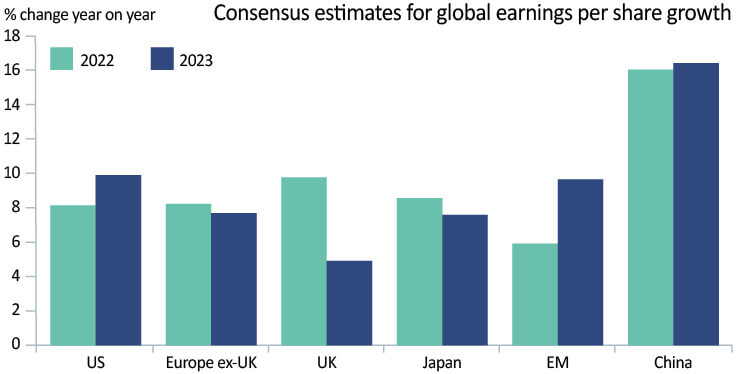
Source: FTSE, IBES, MSCI, Refinitiv Datastream, Standard % Poor’s, TOPIX, J.P. Morgan Asset Management. MSCI indicies are used for Europe ex-UK, EM and China. UK is FTSE All-Share, US is S&P 500 and Japan is TOPIX. Guide to the Markets – UK & Europe. Data as of 19 November 2021.
US equity valuations are undoubtedly higher than average, given their phenomenal performance, but valuations in other regions look far more reasonable. Relative to other assets, particularly bonds, equities still look attractive. Overall, the equity risk premium does not look out of step with history.
Corrections in equity markets are common. There were six of 10% or more in the bull run from 2009-2019 and 5% corrections are a much more regular occurrence – last year was the exception with only a single 5% drawdown in the US. We expect a more normal market environment this year – the market roller-coaster will be more Alton Towers than Peppa Pig World as the last few weeks have shown.
2022’s bestiary of risk – Black swans, grey rhinos and elephants in the room
We have all ignored the elephant in the room and nobody sees the black swan coming, but it is the Chinese grey rhinos – slow moving, obvious but conveniently ignored – that represent the most insidious risks for the coming months.
COVID losing its sting
COVID continues to stalk the economy and can flare quickly as we have seen with the emergence of the Omicron variant, which will surely not be the last. The impact is clear: lockdowns and social distancing stop western consumers getting out and spending on services and hospitality while the stricter approach to lockdowns and lower vaccination rates in the manufacturing centres of Asia impact goods supply and perpetuate bottlenecks. This could lead to slower growth, particularly with government largesse on the wane, while perpetuating supply side inflationary pressures that were expected to prove transitory.
The mortality rate barely increased in South Africa during the Omicron wave
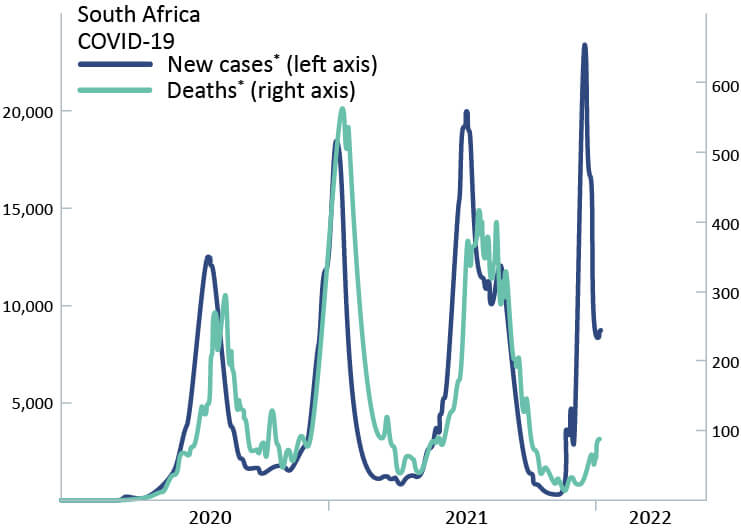
Both series shown as seven-day moving average.
Source: John Hopkins University/Bank of America. January 2022.
Evidence suggests that Omicron is highly infectious but less deadly than previous variants, particularly to those who have been vaccinated. This pattern is consistent with other respiratory diseases, which evolve to become more transmissible but less virulent. While COVID is still here, and future variants may prove more deadly than Omicron, it is now very much a known enemy. Societies have adapted to deal with the disruption, and continued medical innovation – not least Pfizer’s antiviral pill Paxlovid – should allow COVID to move from a pandemic to endemic.
China’s property market – a rhino ready to charge?
Having been the only major economy to grow in 2020 (albeit a below-trend 2.3%), China proved the exception to the recovery rule in 2021, with growth slowing steadily through the year and falling below pre-pandemic rates.
China’s growth is now below pre-pandemic levels
Year-on-year GDP growth, by quarter, with components of change (%)
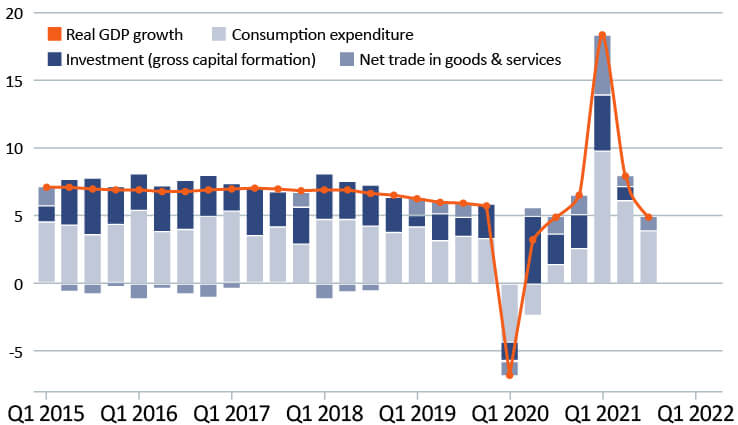
Source: Haver Analytics for the FT.
President Xi Jinping is looking to move China to a new phase of growth after 20 years of rapid development and industrialisation has led to huge wealth creation and the growth of some colossal quoted companies. The new phase targets more sustainable economic growth, a broadening out of wealth across society that should bring greater social equality, and a strategic imperative to address vulnerabilities in domestic security of supply exposed during the trade spat with the Trump administration. A key pillar of this is the ‘common prosperity’ policy – ‘levelling up’ in the UK and ‘build back better’ in the US. The policy has grabbed headlines for its crackdown on the tech giants of Alibaba and Tencent and billionaire founders such as Jack Ma.
However, it is a crackdown on property developers, which began in 2020, that has the potential to put the rhino’s horn somewhere painful. Where the US invests in shares, China invests in property, which represents nearly 70% of private wealth and 30% of total GDP. This is substantially more than in other large economies and a similar level to that in Spain prior to its economic collapse.
China’s property sector is disproportionately large
Real estate-related activities as a share of GDP (%)
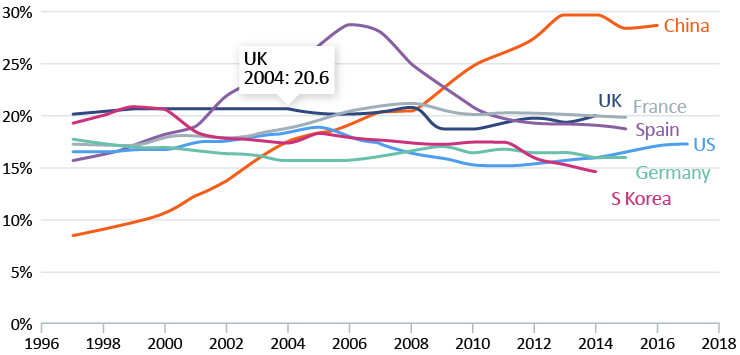
Source: Rogoff & Yang: ‘Peak China Housing’ (NBER 2020)
The property market worries the government for two reasons:
- Affordability reached a point where home ownership is becoming a social issue
- Speculation and leverage in the sector poses a risk to financial stability
The policy has begun to bite for developers. The clearest example is China Evergrande, China’s second biggest property developer with 1,200 projects in 280 cities and one of the world’s most indebted businesses, with US$300 billion of outstanding bonds. Evergrande has already defaulted on some of its dollar bonds and has been forced to suspend its shares. The contagion has moved to other developers, such as Shimao Group Holdings, which recently defaulted on a loan and saw the price of its bonds tumble.
Corporate defaults are not new, and China has previously punished individual companies ‘pour encourager les autres’. Aside from the sheer scale of the Chinese property sector, the challenge for the authorities is twofold:
- Local authority funding has been hugely dependent on land sales to developers for revenue
- The high level of debt associated with property sector means that were defaults to begin to stack up there would be ramifications for the banking sector
If the contagion spreads further, and the dominoes begin to fall, there would be serious consequences for the wider Chinese economy. Ultimately, there is the risk of a deflationary debt and banking crisis – a Chinese equivalent of the global financial crisis, with Evergrande cast as Lehman.
China is better placed to manage a gradual deflation of a property bubble than other countries. It has a relatively closed command economy and sits behind the banks. Encouragingly, having tightened policy already there is scope to cut interest rates and inject liquidity into the system. Tentative steps have already been taken: a 0.5% cut in their reserve requirement ratio should release $1 trillion equivalent into the economy. More will follow. Given the scale of China’s economy, the reverberations of a crisis would have global consequences on demand and sentiment. The government is walking a tightrope, so we are watching the situation closely.
Inflation
Inflation has proven far stickier than many expected. Central banks have already recalibrated their forecasts and brought forward plans to remove stimulus and raise rates, although it is questionable if they would have acted so zealously if economic growth and employment weren’t quite so buoyant.
The risk is that central banks will raise interest rates and reduce liquidity more quickly than anticipated. Further tightening is already expected but slamming on the inflationary brakes could a create a case of monetary whiplash leading to lower corporate earnings and higher borrowing costs.
It is expected that inflation will begin to moderate from current levels as we head through the year. Simple mathematics will help: inflation measures the increase in prices over the previous year and oil, lumber and microchip prices are unlikely to double again in the next 12 months.
The waning impact of COVID should also make a difference. Logistical blockages are dissolving, and markets are responding to shortages of semi-conductors and automobiles. Demand for goods is likely to fade in favour of services as lockdowns ease and people get out and about once more.
Recent data on freight rates and manufacturing surveys would seem to support such a narrative. Short-term measures of inflation are spiking but longer-term rates, while higher than the post-financial crisis years, do not indicate a big departure from either pre-pandemic levels or central bank targets.
Risks remain. Another horrible variant of COVID could see stringent lockdowns back on the agenda. We could also be one cold snap away from another surge in energy prices: Europe’s reliance on Russian natural gas makes Russia’s rumblings on the Ukrainian border uncomfortable, while demand for gas is also high in China to offset coal shortages, and renewables are highly dependent on the weather.
Wages are on the march and are an inflationary pressure that might have staying power. Sustained wage growth has not been seen for some time, the demise of the unions and globalisation provided plenty of competition for jobs and reduced the bargaining power of workers. This has reversed, at least temporarily, and with more jobs than people to fill them wages look set to continue their rise. This provides the clearest route to inflationary surprises being sustained into the latter part of the year.
These risks are quite well known and so should be contained but provide further reasons for our expectation of a rockier ride this year.
The black swans
Beyond the front of mind concerns, we suspect that we may be seeing a longer-term change. After a sustained period of low inflation in recent decades, the pandemic may have acted as the accelerant for a structural change in inflation that could have implications for longer term asset performance. The post-financial crisis world was one of deleveraging, austerity and deflation; the post-pandemic environment has a far more inflationary flavour.
Deglobalisation. Resurgent government spending. The levelling up of society. Decarbonisation. These could prove to be a potent cocktail that brings a hangover of persistently higher prices in future years. Might 2022 prove the year when governments stop focusing on COVID and focus on geopolitical ambitions? These are the potential black swans that could fly from the mists.
But this is a subject for another day. The environment is evolving fast and whatever may come in the year ahead, we will be looking to gauge the impact on portfolios and adjust our holdings accordingly. Powell is not the only one who can pivot!
Long-term index performance
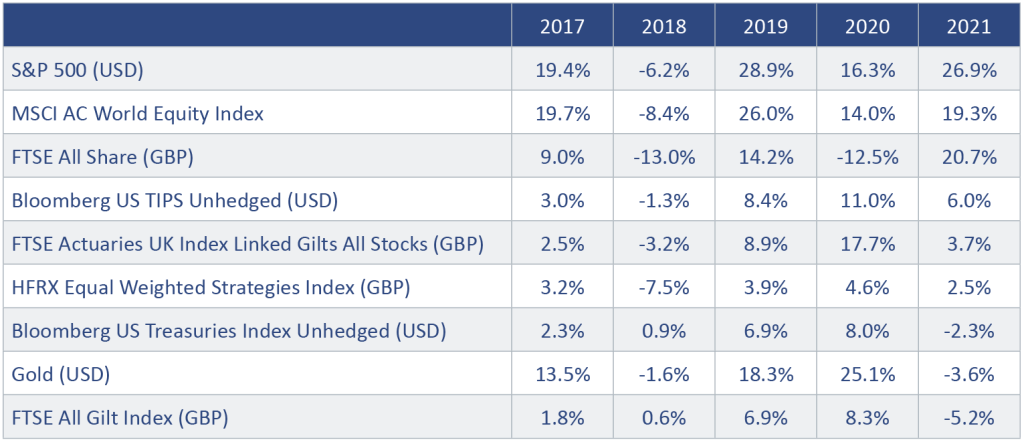
Source: Bloomberg/James Hambro & Partners, January 2022.
Past performance should not be relied on as an indicator of future returns. The value of investments and the income you get from them can go down as well as up and you may not get back the amount invested.